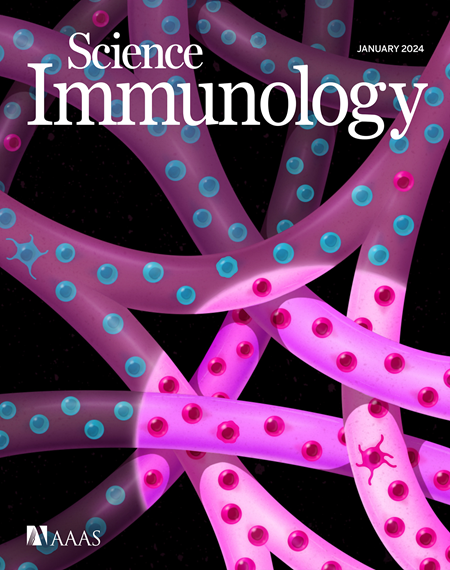Nuclear polarization to the immune synapse facilitates an early transcriptional burst
IF 16.3
1区 医学
Q1 IMMUNOLOGY
引用次数: 0
Abstract
Target cell recognition by cytotoxic T lymphocytes (CTLs) triggers rapid delivery of cytolytic granules to the immune synapse directed by the centrosome. Recent studies have also identified a rapid burst of T cell receptor (TCR)–activated transcription that contributes to CTL-mediated killing. To determine how de novo transcription might be coordinated with intracellular polarization, we asked when transcription factor translocation to the nucleus occurs relative to TCR activation and centrosome polarization within individual CTLs. Upon target cell recognition, the nucleus polarized to and contacted the immune synapse, preceding centrosome docking. The nucleus distorted as it moved, with transcription factors NFAT and NF-κB accumulating in the nucleus during polarization. Inhibition or deletion of myosin IIA prevented both nuclear polarization and transcription factor translocation. Thus, nuclear polarization facilitates an early transcriptional burst that occurs as CTLs encounter targets and the consequent delivery of newly synthesized cytokines to the immune synapse.
免疫突触的核极化促进了早期的转录爆发
细胞毒性T淋巴细胞(ctl)对靶细胞的识别触发由中心体引导的细胞溶解颗粒快速递送到免疫突触。最近的研究还发现T细胞受体(TCR)激活转录的快速爆发有助于ctl介导的杀伤。为了确定从头转录如何与细胞内极化协调,我们询问了在单个ctl中,转录因子易位到细胞核的时间与TCR激活和中心体极化有关。识别目标细胞后,细胞核极化并与免疫突触接触,中心体对接。细胞核在运动过程中扭曲,在极化过程中转录因子NFAT和NF-κB在细胞核中聚集。抑制或删除肌球蛋白IIA可阻止核极化和转录因子易位。因此,核极化促进了ctl遇到靶标时发生的早期转录爆发,并随后将新合成的细胞因子传递给免疫突触。
本文章由计算机程序翻译,如有差异,请以英文原文为准。
求助全文
约1分钟内获得全文
求助全文
来源期刊

Science Immunology
Immunology and Microbiology-Immunology
CiteScore
32.90
自引率
2.00%
发文量
183
期刊介绍:
Science Immunology is a peer-reviewed journal that publishes original research articles in the field of immunology. The journal encourages the submission of research findings from all areas of immunology, including studies on innate and adaptive immunity, immune cell development and differentiation, immunogenomics, systems immunology, structural immunology, antigen presentation, immunometabolism, and mucosal immunology. Additionally, the journal covers research on immune contributions to health and disease, such as host defense, inflammation, cancer immunology, autoimmunity, allergy, transplantation, and immunodeficiency. Science Immunology maintains the same high-quality standard as other journals in the Science family and aims to facilitate understanding of the immune system by showcasing innovative advances in immunology research from all organisms and model systems, including humans.
 求助内容:
求助内容: 应助结果提醒方式:
应助结果提醒方式:


